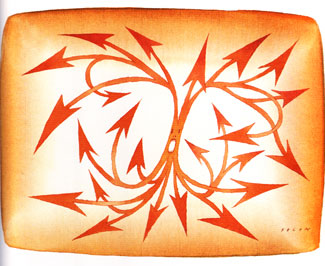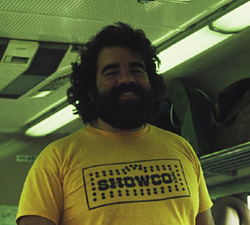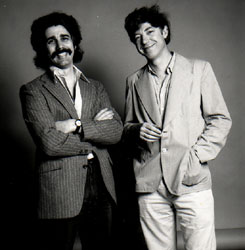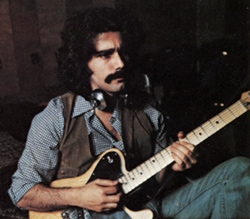

|
Soundclip:
|
| See Steve's Hand-Written Lead
Sheet |
|
Steve
Khan's
lead
sheet:  "Some Arrows" was intended to be nothing more than a classic "fusion shuffle." And, of all the players in the 'family of musicians' here in New York during those years, no one played a better shuffle, than Rick Marotta. His time feel, his sound, his attitude(Wow! What a 'tude!) would give me everything I could ask for. Though it could, at times, seem that Rick's approach to getting his 'sound' out of the drums bordered on bashing them like a 'caveman,' this was absolutely what I was looking for. Perhaps better explained, you want someone who not is afraid to really HIT the drums hard, and to allow the hi-hats to sound almost like two trash can lids coming together, bordering on sounding like 'white noise.' I say all these things, and mean them only as high praise for Rick. One has to have a great touch to achieve these sonic elements too, believe me! And remember, though I mentioned this in the analysis to "An Eye Over Autumn," Michael Brecker always referred to Rick as: "The Elvin Jones of Rock!" So, you can't get much higher praise than that! As it was on all my Columbia recordings, I was joined by two of my closest friends, and all-time favorite bandmates, Will Lee on electric bass and Don Grolnick on both the Fender Rhodes and the Hammond B-3 organ.  Whenever I would compose, and then assemble the music for one of these recordings, it was always in my mind to find solo space for each of the great musicians. As Don's organ solo on "Daily Bulls" from "THE BLUE MAN" was one of my favorite moments on that recording, I wanted to give Don another opportunity to play the Hammond on the new recording. And so, "Some Arrows" would be the perfect vehicle for that. And, as usual, Don's solo has become one of the great highlights of this recording! But, we'll come back to that, let's take a look at the compositional elements and the structure of the piece. Whenever I would compose, and then assemble the music for one of these recordings, it was always in my mind to find solo space for each of the great musicians. As Don's organ solo on "Daily Bulls" from "THE BLUE MAN" was one of my favorite moments on that recording, I wanted to give Don another opportunity to play the Hammond on the new recording. And so, "Some Arrows" would be the perfect vehicle for that. And, as usual, Don's solo has become one of the great highlights of this recording! But, we'll come back to that, let's take a look at the compositional elements and the structure of the piece.Though, generally speaking, it is not one of my favorite things to write in the classic 'guitar keys' of 'E' or 'A,' it seemed obvious that this type of tune cried out to be in 'A.' The sense of harmony which appears in the [I] sections features simple voice-leading with 'D' on top, and the lower voices, in the interval of a 4th, move up in 1/2-steps from an Asus sound, to Bb/A to an Am7sus. The accented voicings you find in bars 3-4 of those sections begin on another Am7sus voicing followed by C# triads over the 'A' bass notes. For the purposes of the lead sheet, I spelled those voicings as Db triads to avoid having to use an E#. I actually don't really remember whether this section was composed at the Rhodes, or on the guitar, because the voicings lay well on each instrument. However, if one is going to play these types of small voicings with a 'power chord'/distortion oriented sound, some of the voicings are going to sound as good as simple 4ths and 5ths. Looking back, if I had the chance to do it again, I would have approached this a little differently to achieve the best possible sound. The tune is really 'glued' together by the recurring 'heavy fusion' triplet lines, which were designed to bring together my Telecaster guitar sound with Rick Marotta's tom-toms.  These one bar lines, which seem to have a very Phrygian flavor to them because of the Bbs, C's and F's, create the transitions from section to section, and serve as a 'rocket' to propel the piece forward. They also create 5-bar phrases which, for this piece, seem very natural, and not forced. These one bar lines, which seem to have a very Phrygian flavor to them because of the Bbs, C's and F's, create the transitions from section to section, and serve as a 'rocket' to propel the piece forward. They also create 5-bar phrases which, for this piece, seem very natural, and not forced.The main melody appears at [A] and is a most simple phrase which moves down a whole-step, and is colored by parallel voicings, except for the last one which I have labled as a D7(#9) over an 'A' bass note. When applying harmony such as this, over a pedal-point, I think that it's best to view these voicing as 'sound shapes' more than trying to over-analyze their relationships to traditional harmonic thinking. Yes, one could name them individually, as I have tried to do, but I'm not so certain that this serves any greater educational purpose. The little transition line found in the 2nd Ending, changes keys and instead of having an 'A' Phrygian flavor, it now has a D Phrygian sound. And it is this line which shoots us into [B], and a change in harmony and rhythmic attitude. We go from being in a rock/fusion shuffle groove to a Latin-oriented 12/8 feeling which was best realized when percussionist, "Crusher" Bennett added a campana to his congas and Rick's drum pattern. If this had been done with a more traditional Afro-Cuban approach, I believe that I should have written it out in 6/8. Though I'm not exactly certain just why it was this way, the [B] section only appears once during the performance, though as you'll see, the changes were used as part of the solo form. As there were no CDs during those years, it's possible that this section never reappeared, with its full melody, because of a concern for fitting all the music on both sides of an LP. But, I don't remember if that was the primary concern or not. These days, such things don't really matter unless one is overly concerned with getting played on the radio! After [B], we reprise the main melodic elements in [A2] before hitting the solo sections, which appear as [C] and [C2]. It is of some interest that the guitar solo form and Don's organ solo form are quite different and reflect the sensibilities of each player. For me, I wanted more time to improvise and explore the A Phrygian area, Gm7(9)/A, and so we all agreed that for me, [C] would be 'open' and of an indeterminate length. From there, we would play [C2], but only ONCE. In between the solos, [A2] would be stated again.  Don's solo form was designed after some discussion, and was based upon what seemed most musical to him, because it was my initial intention that we would both solo over the same format. However, Don suggested that we alter his solo format so that we would play 16 bars of [C] the 1st time, then a full [C2] is played. Then, on the repeat of [C], we only play 8 bars before moving on to [C2]. After all this, we play the transition unison line, and head back to [A2] for the last statement of the main melody. Don's solo form was designed after some discussion, and was based upon what seemed most musical to him, because it was my initial intention that we would both solo over the same format. However, Don suggested that we alter his solo format so that we would play 16 bars of [C] the 1st time, then a full [C2] is played. Then, on the repeat of [C], we only play 8 bars before moving on to [C2]. After all this, we play the transition unison line, and head back to [A2] for the last statement of the main melody.For those of you who are just getting started with improvising, I would like to offer some insights into how these chord changes could be approached, depending upon what sounds good to YOU! Over what I've labeled as Gm9(6)/A, if you are going to analyze this in terms of the root, you would want to think of it as A Phrygian(A, Bb, C, D, E, F, G). However, I tend to translate everything into Dorian, and so I think of it more as G Dorian(G, A, Bb, C, D, E, F) over an A in the bass. And if I play blues-based ideas, they are coming out of the 'G' area moreso than the 'A' area. But, if you study the solo, you will also hear the usage of G melodic minor(G, A, Bb, C, D, E, F#). At one point, I even passed over an Eb as part of a line, and that sounded good as well. For [B], I would make the following recommendations. Over the Abmaj7(6/9) sound, the correct mode should be Ab Lydian(Ab, Bb, C, D, Eb, F, G), but in addition to this to capture a bluesy feeling over a major 7th chord you could use the C minor pentatonic(C, Eb, F, G, Bb), or the G minor pentatonic(G, Bb, C, D, F) which gives you the Lydian sound because of the inclusion of the #4. The Fmaj7(6/9) gets a similar treatment, as you would think in F Lydian, and use the A minor pentatonic(A, C, D, E, G). For what I've labeled as Db/Eb, one must know firstly that it is really Bbm7/Eb, and so that means, in my way of thinking, it is simply Bb Dorian(Bb, C, Db, Eb, F, G, Ab). The last chord which was labeled as E/D, is really a form of a Dmaj7(9#4) and so the mode should be D Lydian(D, E, F#, G#, A, B, C#). The key is that you need to hear C#s and not C-naturals, even though neither note is voiced in the chord!! When one is writing a piece of music, whether it is for a recording or to be performed live, I think that it is crucial to compose an ending. Even if you are going to utilize a fade for the recorded version; and don't get me wrong a fade can be a most effective device; it is important to give a composition a sense of finality, one to which everyone can relate. So, after Don's organ solo, when we return to [A2], we again pass through [I3], which is really just an 8-bar vamp, and then we take the coda and state [A3] for its one and only appearance. Of course, the first 4 bars are exactly like all the other [A] sections which have appeared before, but then there's a little 5-bar [Tag] to give "Some Arrows" a sense of finality.  Here, the melody has gone up a whole-step but receives a completely different harmonic treatment. The notes are harmonized by simple triads over interesting bass notes. If you look at the triads, in the right hand of the keyboard, you'll notice that in bars 1-2 of the [Tag], they are all in the key of 'D.' In bars 3-4, it is down a whole-step and they are in the key of 'C.' I have always believed that if something sounds good, it is not by accident. In music, there really are not any cosmic accidents. If it sounds good, there must be some reason for it. It's interesting that both 'D' and 'C' have a relation to the note 'A' as part of the minor pentatonic for 'A'-minor(A, C, D, E, G). Here, the melody has gone up a whole-step but receives a completely different harmonic treatment. The notes are harmonized by simple triads over interesting bass notes. If you look at the triads, in the right hand of the keyboard, you'll notice that in bars 1-2 of the [Tag], they are all in the key of 'D.' In bars 3-4, it is down a whole-step and they are in the key of 'C.' I have always believed that if something sounds good, it is not by accident. In music, there really are not any cosmic accidents. If it sounds good, there must be some reason for it. It's interesting that both 'D' and 'C' have a relation to the note 'A' as part of the minor pentatonic for 'A'-minor(A, C, D, E, G).This tune is actually the 'title' track from the recording, even though the LP was titled, "ARROWS." I just chose to stick the word "some" in front of it, because I always loved the fact that Randy Brecker titled his famous tune "Some Skunk Funk" and not just "Skunk Funk." So, on each of my recordings there was always one tune with the word "some" in the title. Fortunately, I've gotten away from that 'custom.' Where the "arrows" are concerned, again this was derived from the work of Jean-Michel Folon. He did many paintings and drawings where 'arrows' were an important thematic element. I was very fortunate and honored that Jean-Michel did an original watercolor especially for this recording. It is a beautiful, double-sided cover. As always, Blaine and I are wishing you all a very Happy Thanksgiving and all the joys of the season as the Holidays begin!!!
[Photos of Rick Marotta and Don Grolnick by Randy Brecker, 1974
Photo of Steve and Jean-Michel Folon, and, Steve in the studio Photos by: Jim Houghton '79] |